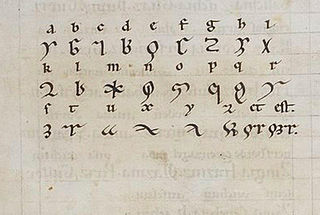
Back Lingua ignota AST Lingua Ignota Byelorussian Lingua Ignota Catalan Lingua ignota German Lingua ignota Esperanto Lingua ignota Spanish Lingua ignota Estonian Lingua ignota Basque Lingua ignota Finnish Lingua Ignota French
| Lingua ignota | |
|---|---|
 St. Hildegard's 23 litterae ignotae. | |
| Pronunciation | [ˈlinɡwa iŋˈnoːta] |
| Created by | Hildegard of Bingen |
| Purpose | Constructed language
|
| Language codes | |
| ISO 639-3 | None (mis) |
| Glottolog | None |
| IETF | art-x-ignota |
| Litterae ignotae | |
|---|---|
| Script type | Alphabet
|
| Creator | Hildegard von Bingen |
Time period | 12th century |
| Direction | Left-to-right |
| Language | Lingua ignota |
| Part of a series on |
| Christian mysticism |
|---|
 |
A lingua ignota (Latin for "unknown language") was described by the 12th-century abbess Hildegard of Bingen, who apparently used it for mystical purposes. It consists of vocabulary with no known grammar; the only known text is individual words embedded in Latin. To write it, Hildegard used an alphabet of 23 letters denominated litterae ignotae (Latin for "unknown letters").[1]
- ^ Bingensis, Hildegardis (1175–1190). Riesencodex. pp. 934, 464v. Archived from the original on 2014-12-20. Retrieved 2014-08-26.